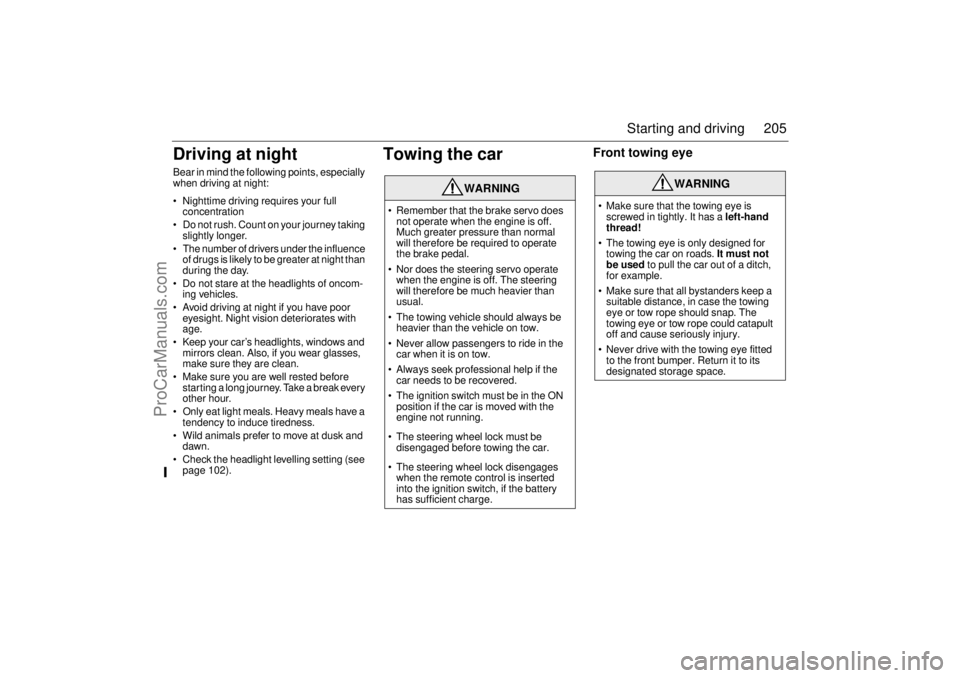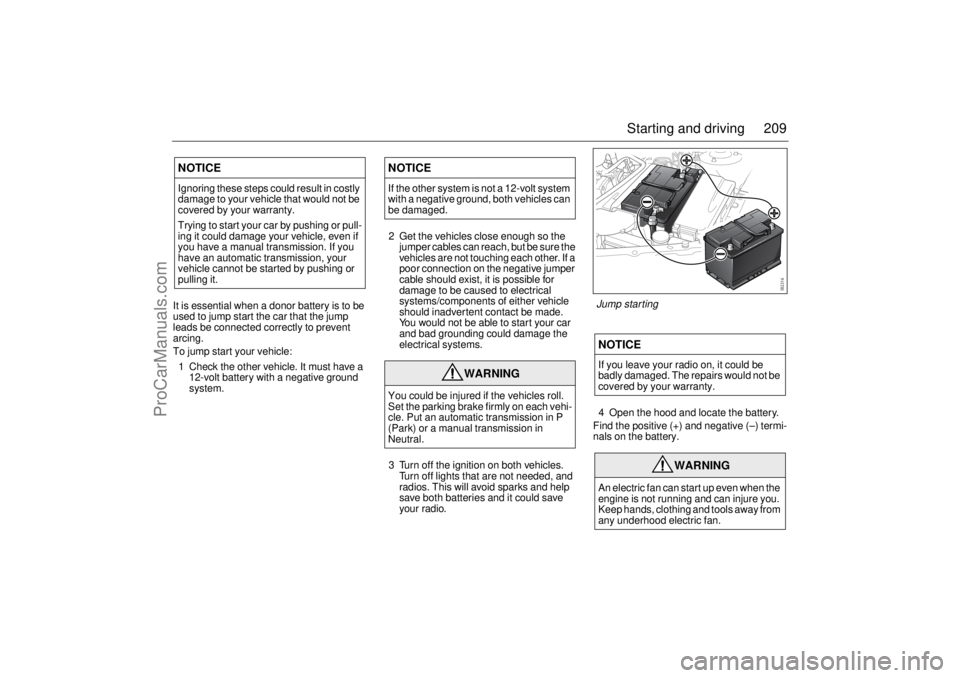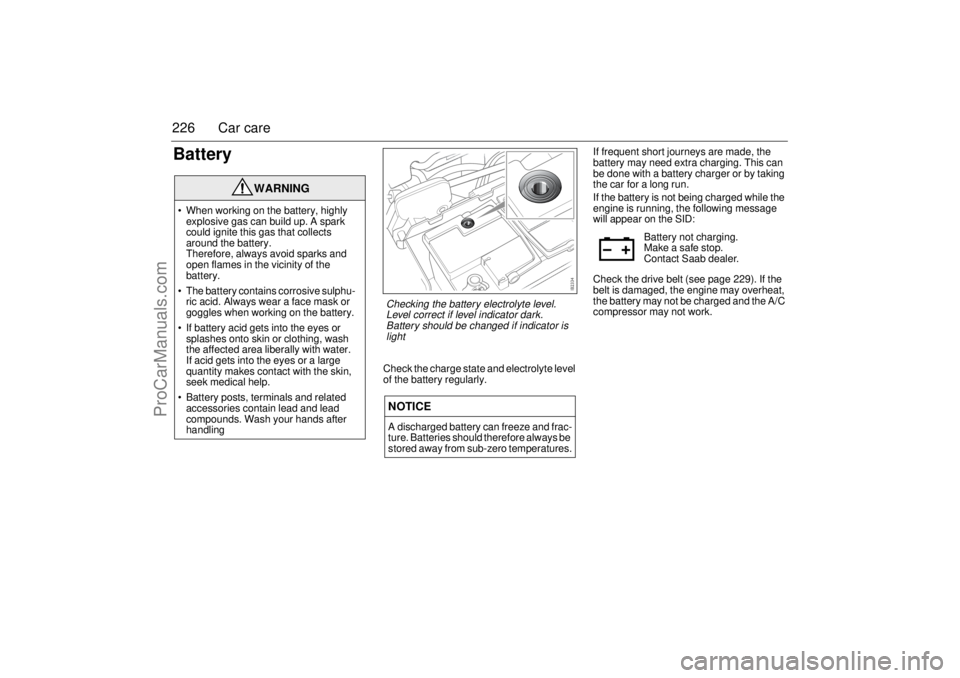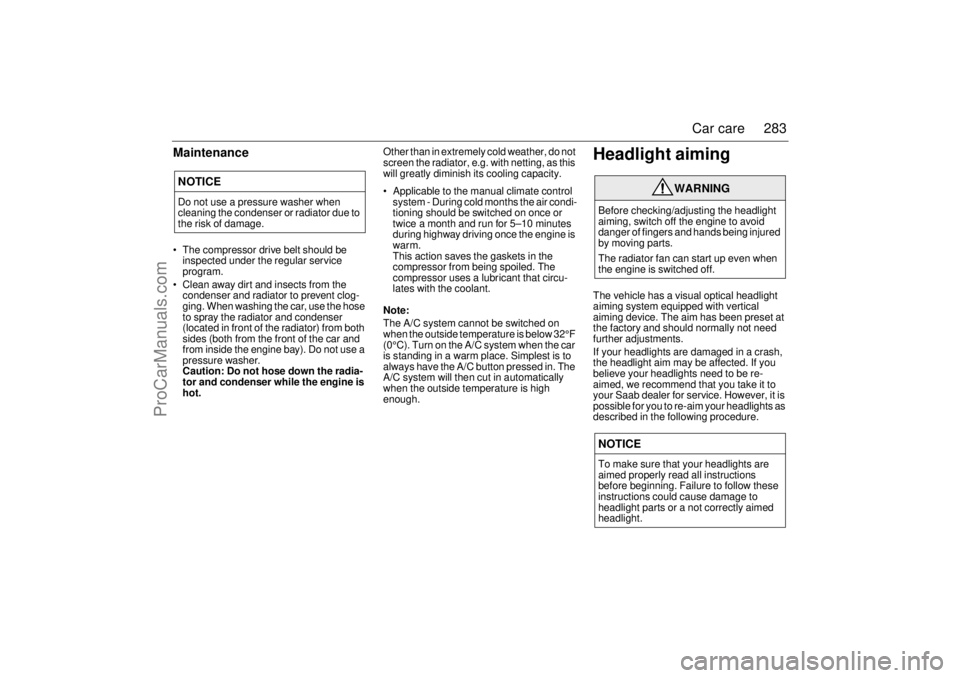check engine light SAAB 9-3 2006 User Guide
[x] Cancel search | Manufacturer: SAAB, Model Year: 2006, Model line: 9-3, Model: SAAB 9-3 2006Pages: 318, PDF Size: 28.05 MB
Page 205 of 318

205 Starting and driving
Driving at nightBear in mind the following points, especially
when driving at night:
Nighttime driving requires your full
concentration
Do not rush. Count on your journey taking
slightly longer.
The number of drivers under the influence
of drugs is likely to be greater at night than
during the day.
Do not stare at the headlights of oncom-
ing vehicles.
Avoid driving at night if you have poor
eyesight. Night vision deteriorates with
age.
Keep your car’s headlights, windows and
mirrors clean. Also, if you wear glasses,
make sure they are clean.
Make sure you are well rested before
starting a long journey. Take a break every
other hour.
Only eat light meals. Heavy meals have a
tendency to induce tiredness.
Wild animals prefer to move at dusk and
dawn.
Check the headlight levelling setting (see
page 102).
Towing the car
Front towing eye
WARNING
Remember that the brake servo does
not operate when the engine is off.
Much greater pressure than normal
will therefore be required to operate
the brake pedal.
Nor does the steering servo operate
when the engine is off. The steering
will therefore be much heavier than
usual.
The towing vehicle should always be
heavier than the vehicle on tow.
Never allow passengers to ride in the
car when it is on tow.
Always seek professional help if the
car needs to be recovered.
The ignition switch must be in the ON
position if the car is moved with the
engine not running.
The steering wheel lock must be
disengaged before towing the car.
The steering wheel lock disengages
when the remote control is inserted
into the ignition switch, if the battery
has sufficient charge.
WARNING
Make sure that the towing eye is
screwed in tightly. It has a left-hand
thread!
The towing eye is only designed for
towing the car on roads. It must not
be used to pull the car out of a ditch,
for example.
Make sure that all bystanders keep a
suitable distance, in case the towing
eye or tow rope should snap. The
towing eye or tow rope could catapult
off and cause seriously injury.
Never drive with the towing eye fitted
to the front bumper. Return it to its
designated storage space.
93U S M 06.book Page 205 Friday, February 18, 2005 1:15 PM
ProCarManuals.com
Page 209 of 318

209 Starting and driving
It is essential when a donor battery is to be
used to jump start the car that the jump
leads be connected correctly to prevent
arcing.
To jump start your vehicle:
1 Check the other vehicle. It must have a
12-volt battery with a negative ground
system.2 Get the vehicles close enough so the
jumper cables can reach, but be sure the
vehicles are not touching each other. If a
poor connection on the negative jumper
cable should exist, it is possible for
damage to be caused to electrical
systems/components of either vehicle
should inadvertent contact be made.
You would not be able to start your car
and bad grounding could damage the
electrical systems.
3 Turn off the ignition on both vehicles.
Turn off lights that are not needed, and
radios. This will avoid sparks and help
save both batteries and it could save
your radio.4 Open the hood and locate the battery.
Find the positive (+) and negative (–) termi-
nals on the battery.NOTICEIgnoring these steps could result in costly
damage to your vehicle that would not be
covered by your warranty.
Trying to start your car by pushing or pull-
ing it could damage your vehicle, even if
you have a manual transmission. If you
have an automatic transmission, your
vehicle cannot be started by pushing or
pulling it.
NOTICEIf the other system is not a 12-volt system
with a negative ground, both vehicles can
be damaged.
WARNING
You could be injured if the vehicles roll.
Set the parking brake firmly on each vehi-
cle. Put an automatic transmission in P
(Park) or a manual transmission in
Neutral.
NOTICEIf you leave your radio on, it could be
badly damaged. The repairs would not be
covered by your warranty.
WARNING
An electric fan can start up even when the
engine is not running and can injure you.
Keep hands, clothing and tools away from
any underhood electric fan.Jump starting
93U S M 06.book Page 209 Friday, February 18, 2005 1:15 PM
ProCarManuals.com
Page 210 of 318

210 Starting and driving5 Check that the jumper cables do not
have loose or missing insulation. If they
do, you could get a shock and also the
vehicles could be damaged.
Before you connect the cables, here are
some basic things you should know.
Positive (+) will go to positive (+) and
negative (–) will go to negative (–). Do
not connect (+) to (–) or you will get a
short that could injure you or would
damage the battery and maybe other
parts as well.
6 Connect the red positive (+) cable to the
positive (+) terminal of the vehicle with
the discharged battery.7 Do not let the other end touch metal.
Connect it to the positive (+) terminal of
the good battery. Use a remote positive
(+) terminal if the vehicle has one.
8 Now connect the negative (–) cable to
the good battery’s negative terminal.
9 Attach the cable to the discharged
battery’s negative terminal.
10 Start the vehicle with the good battery
and run the engine for a while.
11 Try to start the vehicle with the
discharged battery. If it does not start
after a few tries, it probably needs
service.
Note. If the current in the low battery is
too low it might be necessary to wait
several minutes with the cables
connected before you can start the
engine with the low battery.
12 Remove the cables in reverse order to
prevent electrical shorting. Take care
that they do not touch each other or any
other metal.
Using a battery charger3/starter
unitTo avoid damaging the car’s electrical
system and electronics, the following rules
must be followed when charging the battery
or jump starting the car.
If the charger or starter unit can be set to
different voltages (6V/12V/18V/24V), 12V
must be selected.
Follow the manufacturer’s instructions
supplied with the charger or starter unit.
No other apparatus that are grounded or
connected to the mains must be
connected to the car during charging or
jump starting.
The charger or starter unit must under no
conditions produce a voltage greater
than:
16V continuous
18V for 60 min.
If you are unsure about the charge rating of
the unit, disconnect the battery clamp from
the positive terminal before connecting the
unit to the battery.
WARNING
Using a match or flame of any kind near a
battery can cause battery gas to explode.
You can suffer burns or be blinded. Use a
flashlight if you need more light.
Be sure the electrolyte in the battery is not
frozen. Discharged batteries will freeze.
When connecting jumper cables to a
frozen battery, gas from the chemical
reaction inside the battery can build up
under the ice and cause an explosion.
Battery fluid contains acid that can burn
you. Do not get it on you. If you acciden-
tally get it in your eyes or on your skin,
flush the area with water and get medical
help immediately.93U S M 06.book Page 210 Friday, February 18, 2005 1:15 PM
ProCarManuals.com
Page 216 of 318

216 Car careSaab Trionic engine
management systemThe Saab Trionic engine management
system is a unique Saab development that
combines sequential multiport fuel injection,
electronic distributorless ignition and turbo-
charger boost pressure control into one sys-
tem.
The Trionic engine control module (ECM)
monitors many different engine parameters
such as:
Intake manifold pressure.
Intake air temperature.
Crankshaft position.
Engine coolant temperature.
Throttle position.
The oxygen content of the exhaust gases.
The ECM receives information regarding
engine knocking from a sophisticated feed-
back function in the ignition discharge unit.
By processing all of this information, the Tri-
onic system can control fuel injector open-
ing duration, ignition timing and turbo-
charger boost pressure to provide excellent
engine performance while maintaining low
emissions and fuel consumption.
ORVR (Onboard Refueling Vapor
Recovery)All hydrocarbons formed when refueling will
be recovered by the car and not released
into the atmosphere. The hydrocarbons are
absorbed in an evaporative emission canis-
ter. When the engine is subsequently
started, the evaporative emission canister is
gradually purged as air is sucked into it
through a shut-off valve. The hydrocar-
bon/air mixture passes through the evap
canister purge valve and into the engine
where it is burned. “Refueling”, see
page 167.
When refueling, make sure you screw the
filler cap on and keep turning until it has
clicked 3 times.
NOTICEThe Trionic engine management system
continuously monitors the operation of
these systems and has on-board diag-
nostic capabilities (OBD II). If the Engine
malfunction (CHECK ENGINE) light in
the main instrument illuminates, the
Trionic ECM has detected a problem. The
car will continue to operate, but perfor-
mance may be diminished. You should
have your car checked by a Saab dealer
as soon as possible.
93U S M 06.book Page 216 Friday, February 18, 2005 1:15 PM
ProCarManuals.com
Page 226 of 318

226 Car careBattery
Check the charge state and electrolyte level
of the battery regularly.If frequent short journeys are made, the
battery may need extra charging. This can
be done with a battery charger or by taking
the car for a long run.
If the battery is not being charged while the
engine is running, the following message
will appear on the SID:
Check the drive belt (see page 229). If the
belt is damaged, the engine may overheat,
the battery may not be charged and the A/C
compressor may not work.
WARNING
When working on the battery, highly
explosive gas can build up. A spark
could ignite this gas that collects
around the battery.
Therefore, always avoid sparks and
open flames in the vicinity of the
battery.
The battery contains corrosive sulphu-
ric acid. Always wear a face mask or
goggles when working on the battery.
If battery acid gets into the eyes or
splashes onto skin or clothing, wash
the affected area liberally with water.
If acid gets into the eyes or a large
quantity makes contact with the skin,
seek medical help.
Battery posts, terminals and related
accessories contain lead and lead
compounds. Wash your hands after
handling
NOTICEA discharged battery can freeze and frac-
ture. Batteries should therefore always be
stored away from sub-zero temperatures.
Battery not charging.
Make a safe stop.
Contact Saab dealer.
Checking the battery electrolyte level.
Level correct if level indicator dark.
Battery should be changed if indicator is
light
93U S M 06.book Page 226 Friday, February 18, 2005 1:15 PM
ProCarManuals.com
Page 232 of 318

232 Car care
Changing bulbsAutochecking of lightsThe bulbs that are most important from the point of view of traffic
safety are monitored by the car’s electrical system. If one of these
bulbs should fail, a message will be displayed on the SID.
Example of SID message:
The following bulbs are not checked: parking lights, front fog lights,
reversing lights, license plate lighting, side marker lights and side
direction indicators.
SportCombi
The tail lights and brake lights consist of LEDs. If approx. 3/4 of the
LEDs on one side are broken then this is indicated in the SID.If a stop light bulb fails
Sport Sedan: If a stop light bulb fails, the adjacent taillight will act
as a stop light to ensure traffic safety. Change the broken bulb when
possible.
All rear light bulbs are of the same type and rated 21 W, with the
exception of the license plate lighting which is rated 5 W.
Wrong bulb fitted
If a dipped or main beam bulb of too high a rating is fitted, a bulb
failure message will be shown on the SID (a too high wattage bulb
can damage the reflector).
If the following message is displayed but the bulb shines, it is most
likely that an incorrect bulb has been fitted.
Note:
When changing bulbs, fit the same type of bulb (e.g. Long-Life)
as that removed.
Headlight aiming, page 283.
WARNING
Before changing a bulb in the engine bay, switch off the engine
to avoid the danger of fingers and hands being injured by moving
parts.
The radiator fan can cut in even when the engine is switched off.NOTICESwitch off the ignition before changing a bulb, to avoid possible
short-circuiting.
Left low beam failure.
Right high beam failure.
93U S M 06.book Page 232 Friday, February 18, 2005 1:15 PM
ProCarManuals.com
Page 283 of 318

283 Car care
Maintenance The compressor drive belt should be
inspected under the regular service
program.
Clean away dirt and insects from the
condenser and radiator to prevent clog-
ging. When washing the car, use the hose
to spray the radiator and condenser
(located in front of the radiator) from both
sides (both from the front of the car and
from inside the engine bay). Do not use a
pressure washer.
Caution: Do not hose down the radia-
tor and condenser while the engine is
hot.Other than in extremely cold weather, do not
screen the radiator, e.g. with netting, as this
will greatly diminish its cooling capacity.
Applicable to the manual climate control
system - During cold months the air condi-
tioning should be switched on once or
twice a month and run for 5–10 minutes
during highway driving once the engine is
warm.
This action saves the gaskets in the
compressor from being spoiled. The
compressor uses a lubricant that circu-
lates with the coolant.
Note:
The A/C system cannot be switched on
when the outside temperature is below 32°F
(0°C). Turn on the A/C system when the car
is standing in a warm place. Simplest is to
always have the A/C button pressed in. The
A/C system will then cut in automatically
when the outside temperature is high
enough.
Headlight aimingThe vehicle has a visual optical headlight
aiming system equipped with vertical
aiming device. The aim has been preset at
the factory and should normally not need
further adjustments.
If your headlights are damaged in a crash,
the headlight aim may be affected. If you
believe your headlights need to be re-
aimed, we recommend that you take it to
your Saab dealer for service. However, it is
possible for you to re-aim your headlights as
described in the following procedure.
NOTICEDo not use a pressure washer when
cleaning the condenser or radiator due to
the risk of damage.
WARNING
Before checking/adjusting the headlight
aiming, switch off the engine to avoid
danger of fingers and hands being injured
by moving parts.
The radiator fan can start up even when
the engine is switched off.NOTICETo make sure that your headlights are
aimed properly read all instructions
before beginning. Failure to follow these
instructions could cause damage to
headlight parts or a not correctly aimed
headlight.
93U S M 06.book Page 283 Friday, February 18, 2005 1:15 PM
ProCarManuals.com
Page 313 of 318

313 Index
Index
AA/C
__________________________ 113
Adjustment, steering wheel
________ 128
Air conditioning
_________________ 113
Air filter
_______________________ 222
Airbag
_________________________ 32
Anchorage eyes
________________ 149
Anti-corrosion treatment
__________ 280
Antilock braking system __________ 181
Anti-spin
______________________ 183
Ashtrays ______________________ 144
Autochecking of lights, warning and
indicator lights
__________________ 88
Autodimming
_______________ 133
, 134
Automatic climate control (ACC)
____ 115
Automatic tire pressure monitoring __ 254
Automatic transmission
___________ 173
ABS brakes
____________________ 181
ACC
_________________________ 115
BBattery
_______________________ 226
Bedding-in of new brake pads
_____ 171
Before towing a trailer
____________ 201
Brake fluid, grade
_______________ 303Brakes
________________________ 180
Braking _______________________ 180
Bulb changing
__________________ 232
Bulb table
_____________________ 246
Buying new tires
________________ 260
CCabin lighting
__________________ 141
Cabin lighting, Convertible
_________ 80
Car alarm
______________________ 58
Car transport ___________________ 207
Care of air conditioning
___________ 283
Change of address notification
_____ 290
Changing a tire
_________________ 273
Changing bulbs _________________ 232
Changing engine oil
_____________ 220
Changing the battery, remote control
_56
Changing wiper blades
___________ 230
Checking the number of remote
controls
_______________________ 55
Checks before towing a trailer
_____ 201
Child safety
_____________________ 24
Child safety locks, rear doors
_______ 54
Child seats
_____________________ 24
Cigarette lighter
_________________ 144
Cleaning the engine bay
__________ 277
Cleaning upholstery
_____________ 276
Climate control system, manual
____ 110
Closing the soft top manually,
Convertible
____________________ 70Closing the soft top, Convertible
_____ 66
Clutch interlock
_________________ 172
Compact spare _________________ 270
Compass
______________________ 137
Condensation water, A/C
_________ 113
Convertible
_____________________ 63
Convertible, washing
_____________ 278
Coolant
_______________________ 222
Crash memory, see EDR
_________ 292
Cruise control
__________________ 179
Cup holder
_____________________ 142
DDate codes, tires
________________ 270
Deep water, driving through
_______ 204
Definitions and terminology, tire ____ 267
Determining correct load, tires
_____ 269
Direction indicator stalk switch _____ 104
Direction indicators
______________ 104
Dome light, Convertible
___________ 243
Dome light, Sport Sedan __________ 242
Donor battery, boost starting
_______ 208
Door handles
____________________ 50
Door mirrors ___________________ 132
Drive belt
______________________ 229
Drive belt, length
________________ 301
Driver’s seat with memory
__________ 21
Driving at night
_________________ 205
Driving in cold climates
___________ 195
Driving in deep water
_____________ 204
93U S M 06.book Page 313 Friday, February 18, 2005 1:15 PM
ProCarManuals.com
Page 314 of 318

314 IndexDriving in hot climates
____________ 197
Driving techniques
______________ 193
Driving with a heavy load on hilly
roads
________________________ 175
Driving with a load
______________ 204
Driving with a roof load ___________ 202
Driving with the compact spare wheel
208
Driving with the trunk lid open
______ 204
EEasy entry, Convertible
____________ 75
Economical motoring
____________ 193
Electric engine heater ____________ 194
Electric heating, front seats
___ 114
, 123
Electric windows
________________ 129
Electric windows, Convertible
_______ 79
Electrical system, technical data ____ 300
Electrically adjustable seats
________ 20
Electronic steering wheel lock _____ 162
Electronic Stability Program (ESP)
__ 185
Emergency opening of the narrow
backrest
_____________________ 150
Emergency operation of the sunroof
_ 140
Engine bay, cleaning
____________ 277
Engine heater
__________________ 194
Engine immobilizer
_______________ 57
Engine number
_________________ 307
Engine oil, checking
_____________ 219
Engine oil, grade
________________ 298
Engine oil, volume ______________ 299Engine temperature gauge
_________ 90
Engine, description
______________ 215
Engine, technical data ____________ 297
Engines
_______________________ 300
Event Data Recorders (EDR)
______ 292
Extra electrical socket
____________ 144
EDR (Event Data Recorders)
______ 292
ESP, anti-skid system
____________ 185
FFacilitating entry to rear seat,
Convertible
____________________ 75
Factors affecting fuel consumption
__ 193
Filler cap
______________________ 168
Filling a portable fuel container
_____ 169
Filling up
______________________ 167
Flat spots, tires
_________________ 259
Floor jack
_____________________ 274
Folding down the rear seat
________ 146
Front fog lights
_________________ 104
Front towing eye ________________ 205
Fuel container
__________________ 169
Fuel gauge
_____________________ 91
Fuel grade _____________________ 299
Fuel information
________________ 169
Functions, car alarm ______________ 61
Fuse panel in luggage compartment
_250
Fuse table
_____________________ 249
Fuses
________________________ 247
GGear selector indicator, automatic
transmission
___________________ 92
Gearbox number ________________ 307
General safety instructions,
Convertible
____________________ 64
Glove box
_____________________ 144
Glovebox lighting
________________ 244
GDO, garage door opener
_________ 134
HHandbrake
_____________________ 187
Hazard warning lights
____________ 105
Head restraint, Convertible
_________ 76
Head restraints
__________________ 23
Headlight flasher ________________ 103
Headlight levelling _______________ 102
Headlights
_____________________ 102
Heated door mirrors
_____________ 114
Hood
_________________________ 214
Horn __________________________ 128
Horn button
____________________ 128
IIf a tire goes flat
_________________ 264
Ignition switch
__________________ 160
Immobilizer
_____________________ 57
93U S M 06.book Page 314 Friday, February 18, 2005 1:15 PM
ProCarManuals.com
Page 316 of 318

316 IndexPinch protection, electric windows
__ 130
Pinch protection, sunroof
_________ 140
Plates and labels, location ________ 307
Polishing and waxing
____________ 279
Poly-V-belt
____________________ 229
Portable fuel container
___________ 169
Position lights
__________________ 102
Power steering fluid, checking
_____ 225
Power steering fluid, grade
________ 302
Pressure gauge
_________________ 90
Pressure, tires
__________________ 257
Profiles, customized settings
_______ 93
QQuality grading, tires
_____________ 261
Quick guide, remote control
________ 51
RRain sensor
____________________ 107
Raising the soft top manually,
Convertible ____________________ 70
Reading lights, Convertible
_________ 80
Rear fog light
__________________ 104
Rear seats, folding down
_________ 146
Rear towing eye
________________ 206
Rear window heating
____________ 114
Rearview mirrors
________________ 132
Recirculation
___________________ 113Recommendations for automatic
transmission, towing a trailer
_____ 199
Recommendations for manual
gearbox, towing a trailer
_________ 200
Recommended snow chains _______ 304
Refueling
______________________ 167
Remote control
__________________ 50
Remote locking malfunction
________ 52
Replacement, wheel
_____________ 262
Reporting safety defects __________ 291
Rev counter
_____________________ 88
Reversing lights
________________ 105
Rollover Pop-up Bars, Convertible
___ 78
Roof lighting
___________________ 141
Roof lighting, changing
___________ 242
Running-in
_____________________ 171
SSaab Information Display
__________ 93
Saab Parking Assistance _________ 190
Saab Trionic engine management
system
______________________ 216
Safety belts _____________________ 12
Seatbelts
_______________________ 12
Seatbelts in rear seat, Convertible
___ 77
Seatbelts, care
_________________ 276
Seatbelts, checking
______________ 276
Seats
__________________________ 18
Securing a load
_________________ 149
Sentronic, manual gear selection
___ 178Service costs
___________________ 289
Service information
______________ 290
Service intervals
________________ 288
Service record retention
__________ 289
Signalling, horn
_________________ 128
Ski hatch
______________________ 148
Spare wheel ___________________ 270
Speed ratings, tires
______________ 266
Speedometer
____________________ 89
Starting the engine
______________ 162
Steering wheel adjustment
________ 128
Steering wheel lock
______________ 162
Steps for determining correct load
limit
_________________________ 269
Storage compartments
___________ 144
Sun visor
______________________ 142
Sunroof
_______________________ 138
Switches ______________________ 102
SAHR, head restraint
_____________ 23
SDM
_________________________ 292
SID
___________________________ 93
SPA __________________________ 190
TTechnical data
__________________ 294
Textile carpeting, cleaning
_________ 277
Tie down eyes
__________________ 149
Tightening torque, wheels
_________ 275
Tire chains
_____________________ 263
Tire date code __________________ 270
93U S M 06.book Page 316 Friday, February 18, 2005 1:15 PM
ProCarManuals.com